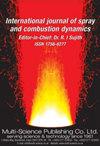Experimental investigation on spray characteristics of Jet A-1 and alternative aviation fuels
IF 2.1
4区 工程技术
Q3 ENGINEERING, MECHANICAL
International Journal of Spray and Combustion Dynamics
Pub Date : 2021-06-01
DOI:10.1177/17568277211010140
引用次数: 13
Abstract
Potential alternative fuels that can mitigate environmental pollution from gas turbine engines (due to steep growth in the aviation sector globally) are getting significant attention. Spray behavior plays a significant role in influencing the combustion performance of such alternative fuels. In the present study, spray characteristics of Kerosene-based fuel (Jet A-1) and alternative aviation fuels such as butyl butyrate, butanol, and their blends with Jet A-1 are investigated using an air-blast atomizer under different atomizing air-to-fuel ratios. Phase Doppler Interferometry has been employed to obtain the droplet size and velocity distribution of various fuels. A high-speed shadowgraphy technique has also been adopted to make a comparison of ligament breakup characteristics and droplet formation of these alternative biofuels with that of Jet A-1. An effort is made to understand how the variation in fuel properties (mainly viscosity) influences atomization. Due to the higher viscosity of butanol, the SMD is higher, and the droplet formation seems to be delayed compared to Jet A-1. In contrast, the lower viscosity of butyl butyrate promotes faster droplet formation. The effects of the blending of these biofuels with Jet A-1 on atomization characteristics are also compared with that of Jet A-1.Jet A-1及其替代航空燃料喷雾特性的实验研究
潜在的替代燃料可以减轻燃气涡轮发动机对环境的污染(由于全球航空业的急剧增长)正在受到极大的关注。喷雾特性对这类替代燃料的燃烧性能有重要影响。在不同的雾化空气燃料比下,利用空气雾化喷嘴研究了煤油基燃料(Jet A-1)和替代航空燃料(如丁酸丁酯、丁醇)及其与Jet A-1的混合燃料的喷雾特性。采用相位多普勒干涉法测量了不同燃料的液滴大小和速度分布。采用高速阴影成像技术,将这些替代生物燃料的韧带断裂特性和液滴形成与Jet A-1进行比较。努力了解燃料性质(主要是粘度)的变化如何影响雾化。由于丁醇的粘度更高,SMD更高,与Jet A-1相比,液滴的形成似乎延迟了。相反,丁酸丁酯的低粘度促进了更快的液滴形成。将这些生物燃料与Jet A-1混合对雾化特性的影响也与Jet A-1进行了比较。
本文章由计算机程序翻译,如有差异,请以英文原文为准。
求助全文
约1分钟内获得全文
求助全文
来源期刊

International Journal of Spray and Combustion Dynamics
THERMODYNAMICS-ENGINEERING, MECHANICAL
CiteScore
2.20
自引率
12.50%
发文量
21
审稿时长
>12 weeks
期刊介绍:
International Journal of Spray and Combustion Dynamics is a peer-reviewed open access journal on fundamental and applied research in combustion and spray dynamics. Fundamental topics include advances in understanding unsteady combustion, combustion instability and noise, flame-acoustic interaction and its active and passive control, duct acoustics...
 求助内容:
求助内容: 应助结果提醒方式:
应助结果提醒方式:


